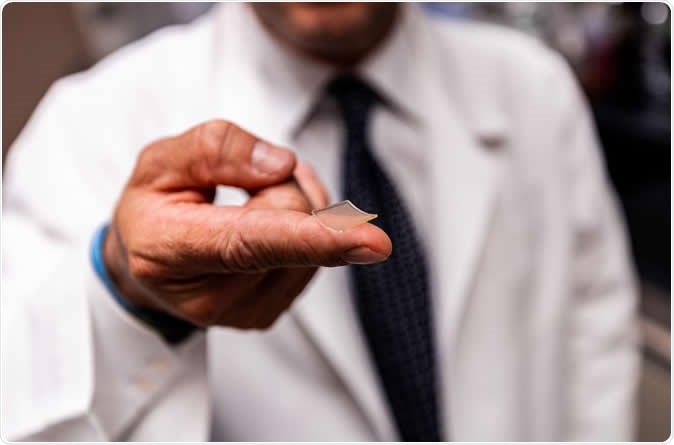In a breath of fresh air, scientists from the University of Pittsburgh School of Medicine reported that they had developed a potential new vaccine against the SARS-CoV-2 virus, which is causing the current COVID-19 pandemic. The vaccine has been tested in mice. When administered through a small patch only the size of a fingertip, the vaccine was found to generate protective neutralizing antibodies against the virus, in adequate quantities.

The vaccine is delivered into the skin through a fingertip-sized patch of microscopic needles. Image Credit: UPMC
Commenting on this fortunate fact, researcher Andrea Gambotto says, "We had previous experience on SARS-CoV in 2003 and MERS-CoV in 2014. These two viruses, which are closely related to SARS-CoV-2, teach us that a particular protein, called a spike protein, is important for inducing immunity against the virus. We knew exactly where to fight this new virus." This is the reason to fund vaccine research, he stresses, because pandemics and epidemics are unpredictable.
Another researcher, Louis Falo, says the vaccine was developed quickly by using the expertise of different types of scientists who came together to achieve a single goal. The approach they used differs from the experimental mRNA vaccine that has begun clinical trials.
PittCoVacc
The new candidate vaccine, which they call PittCoVacc (Pittsburgh Coronavirus Vaccine), is built from synthetic viral protein antigens, just like the flu vaccine. It is designed to be delivered by a microneedle array, a patch of 400 extremely fine needles composed of just sugar and the protein antigens. The microneedles, which enhance the effectiveness of the vaccine, are mounted on a patch the size of a fingertip. The patch is applied on the skin (similar to a Band-Aid) so that the microneedles drive into the skin and dissolve to achieve the greatest possible immune reaction.
Falo says, "We developed this to build on the original scratch method used to deliver the smallpox vaccine to the skin, but as a high-tech version that is more efficient and reproducible patient to patient."
Advantages
The use of microneedles makes the vaccine "pretty painless," "kind of like Velcro," according to the investigators. Moreover, the system can be scaled up and down because of its design. This is particularly important because of the large-scale requirement in the current pandemic.
The protein fragments are synthesized within a cell culture composed of layers of cells that act like a cell factory, containing the genes that express the spike protein of the SARS-CoV-2. These cells can be stacked in layers to obtain a greater yield. The protein can be purified at an industrial scale.
The microneedle array can be mass-produced by spinning a customized mixture of protein and sugar using a centrifuge, into a mold. The manufactured vaccine can be stored at room temperature until the time of use. This avoids the need to refrigerate it during storage and transport.
The first test
The investigators tested out the vaccine in mice. They found that it produced a sudden rise of antibodies against the virus within two weeks of patch application.
They are still waiting to see how the vaccine performs long-term. However, judging from earlier trials on the MERS-CoV vaccine, the long-term efficacy should be adequate. The antibodies produced in the MERS-CoV trial were at a high enough level to stave off infection for at least a year, and the current trend with the anti-SARS-CoV-2 antibody levels in the vaccinated mice reflect the same kind of rise.
And finally, the microneedle vaccine keeps its potency even when irradiated with gamma rays, which is essential to its use in humans, to ensure that no infectious agents are being introduced in a living form into the individual.
The future
The researchers are now applying for investigational new drug approval from the US Food and Drug Administration so that they can test the drug's performance in phase I clinical trials over the next few months. Such testing usually takes a year or more. However, the distinctive nature of the current situation may mean that this particular round of testing may advance faster.
Falo says, "We don't know how long the clinical development process will take. Recently announced revisions to the normal processes suggest we may be able to advance this faster."
Journal reference:
Microneedle array delivered recombinant coronavirus vaccines: Immunogenicity and rapid translational development Kim, Eun et al. EBioMedicine, https://www.thelancet.com/journals/ebiom/article/PIIS2352-3964(20)30118-3/fulltext